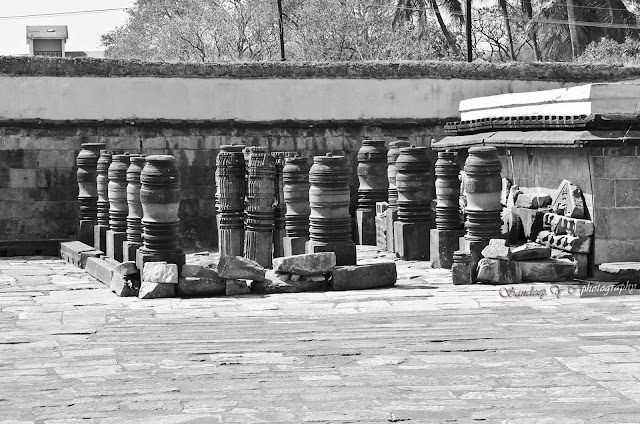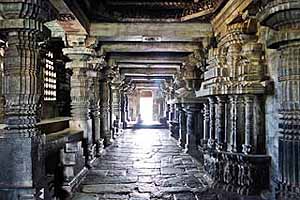Belur Halebeedu – Climax of Indian Architecture:
The temple of Belur and Halebeedu, has been described as an “outstanding example of Hindu Architecture” and as the “Supreme Climax of Indian Architecture”. This must be the most beautiful Hindu sculptures made in the whole world.
The Hoysala era was an important period in the development of Art, Architecture and Religion in South India. The empire is primarily remembered today for its temple Architecture. At present day there are over a hundred temples scattered across Karnataka of which Chennakeshava temple at Belur, the Hoysaleshwara temple at Halebeedu, and the Keshava temple at Somanathapura are the most important and beautiful. Other temples include Viranarayana Temple at Belavadi, Isvara Temple at Arasikere, Lakshminarayana temple at Hosaholal and Lakshminarasimha temple at Javagal.
 |
| Belur Temple complex, with the main entrance Gopura on the right |
One more weekend, and this time it was a long weekend of Sankranthi festival and we had left Bangalore on Saturday morning at 6.30AM in two of our cars, we headed towards the NH4 towards Tumkur and then took a left at the Bangalore-Mangalore highway (NH48) at Nelamangala after the toll gate. This newly constructed highway is 4-lanned up to almost half way built by Lanco Infra, the remaining half way was under construction by L & T. So we almost zoomed the halfway easily passing by two of the toll gates on NH48, both charged 54Rs each for a double way entry. Altogether crossed three toll gates (Rs133). Just about half way we stopped for our breakfast at Hotel Café Kamat (Veg), had some decent dosa’s here and then continued through the route which was under construction so our speed dropped here when we finally arrived near Hassan, and we continued on the highway as shown on our GPS, but unfortunately we were fooled nearly by the GPS navigation as it showed a shorter way but horrible road to connect to the Belur road, the actual proper route was to take a right at the circle just after passing the Rajeev Institute of Technology which falls on the left side of the highway. From there you can connect to the BM road and then to the Belur road. Best option is to enquire the locals about the roads. As our first stop was at Belur we followed the Belur road directly to Belur Chennakeshava temple, parked our vehicles at the free parking space provided in front of the temple, and then entered the main entrance of the temple.
 |
| Hotel cafe Kamat on the Highway NH48 |
Facts and History about Belur: Belur was the first capital of the Hoysala kingdom; it was also called as Velapuri or Velapura. It is situated on the banks of the river Yagachi. It is now located in the District of Hassan, and the nearest city Chikmangalur is 25km away from Belur. Hoysala’s after having defeated the Chalukyas, rose above all to become the parsamount rulers even over the Cholas and Pandyas in South India. Hoysala’s ruled from 1026-1343 A.D., By the 13th century, they governed most of the Karnataka, parts of Tamil Nadu and Kerala, and parts of western Andhra Pradesh in Deccan India.
Belur Temple Complex:
The first thing you notice while entering is the tall gopura structure built in the later period by Vijayanagara kings in the 16th Century A.D. Most if the time the gopura was occupied by birds.
The other temples which are added in the later period within the complex are Kappe Channigaraya temple, Veera Narayana temple, Saumyanayaki temple, and Goddess Andal temple.
The whole temple complex is enclosed with tall wall structure and the main entrance is crowned by a Rayagopura built during the days of Vijayanagar, a flagpole stands in the foreground and a Pushkarni or stepped well to the right side of the main entrance, is situated in the north east corner of the complex.
 |
| Flagpole infront of the gopura |
 |
| Pushkarni or stepped well, belur |
Inside the temple complex, is the Chennakeshava temple at the center which faces to the east. There is Kappe Chennigaraya temple situated to the south of the Chennakeshava temple. To the south-west of the Keshava temple is the temple of Saumyanayaki. The Veera Narayana temple to the west of Keshava temple. The temple of the goddess Andal is situated to the north west of the Keshava temple.
Kappe Channigaraya temple:
Situated to the south of the Keshava temple in the complex has two cells. This temple has the features more or less similar to the Chennakeshava temple but miniature in scale. The main cell has a beautiful sculpture of Chennakeshava 6.5feet tall. The Prabhavali has Dasavatara sculptures. There is an inscription of Shantala the senior queen of Haysala King Vishnuvardhana stating that it was consecrated by her in the year 1117 A.D. The temple raises over an elevated platform. The perforated jalandras of the temple were got executed by Hoysala Ballala-II in 1206. The Sukhanasi doorway is beautifully executed and has a figure of Lakshminarayana flanked by makaras on the lintel. The doorway of the Venugopala shrine has the figure of Narasimha killing Hiranyakshipu. The niches on the outer walls of the Sukhanasi has the beautiful sculptures of Lakshminarayana, Ganesha, Saraswati and Mahishamardini. The four pillars of the navaranga, are lathe turned and have bracket figures on them. The central ceiling has Hoysala emblems and lotus medalions.
 |
| Kappe Chennigaraya temple in the left and Chennakeshava temple on the right. Both look identical |
To the south-west of Keshava temple is the temple of Saumyanayaki. It has a Garbhagriha, surmounted by a tower. According to an inscription the original tower which was damaged was got repaired in 1387 by Muddappa a minister under the Vijayanagara king Harihara II – and a metal Kalasa or finial was fixed on it. The front portion of this temple is a later addition built by the Dalavayi family of Kalale.
 |
| Saumyanaki temple is the left and Chennakeshava temple at the center. Also in the pic is the flagpole in the front |
Veera Narayana Temple:
Located to the west of the Chennakeshava temple is a small and compact structure with the outer walls containing beautiful sculptures of vaishnava and shaiva faith. It consists of a Garbhagriha, a sukhanasi and a Navaranga. The 59 large images on the outer wall surfaces consists of Vishnu, Shiva, Brahma, Parvati, Saraswati, Bhairava, Ganesha and many more. The temple is raised on an elevated basement and is contemporary to the Chennakeshava temple. This was also said to be built in 1117 A.D.
 |
| Veera Narayana Temple, Belur |
 |
| Veera Narayana Temple, Belur |
 |
| Remains of some temple kept inbetween Veera Narayana and Andal temples |
Andal (Ranganayaki) Temple:
The temple of the goddess Andal is said to be built in 12th century, and is situated to the north west of the Chennakeshava temple is also locally known as Ranganayaki temple. The basement has friezes of elephants, scroll work and puranic scenes. The temple has the appearance of having been built with the materials belonging to some ruined temple of Hoysala period.
 |
| Andal (Ranganayaki) temple, belur |
The temple is known for the row of 31 large images on the outer walls. The canopies over these images, which differ from one another, show elegant workmanship. The deities represented here are Lakshmi, Mohini, Venugopala, Lakshminarayana flanked by female chauri bearers and etc.
Two of the images on the south wall have the names of the sculptors Bechama and Madhuvanna who carved them.
 |
| Sculptures on the walls of Andal (Ranganayaki) temple, belur |
Having walked all around the Chennakeshava temple through the temple complex, it was now time for some exciting instants to enter the Main temple which I’ll be unfolding in my next post.
 |
| Model gopura of Chennakeshava temple on the right & the Main gopura of the belur temple complex entrance on the left |
Chennakeshava temple of Belur…To be continued…
Related Posts

|
Belur Chennakeshava temple |

|
Belur Chennakeshava temple Interiors |

|
Belur Chennakeshava temple Madanikas |

|
Hoysaleshwara temple of Halebeedu - Interiors |

|
Hoysaleshwara temple Sculptures - Exteriors |

|
Hoysaleshwara temple Nandi Mandapas and Museum |

|
Kedareshwara temple and Parshwanatha Jain Basadi |

|
Somnathpur Keshava Temple |

Very useful tips.....................Vedic Architects & Sculptors a the leading Temple Architectural firms in Chennai and temple designer in India and abroad, and have been doing sculptures, vastu, stone carving and Monuments designers in Chennai.
ReplyDeleteMonuments Designers In Chennai
I'm immensely thankful to you for sharing very valuable pictures and information
ReplyDelete